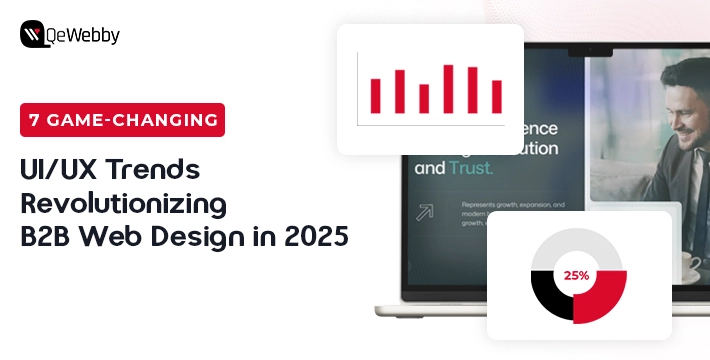In the B2B landscape, first impressions are often digital. Your website speaks before your team does.
With buyers conducting extensive online research before ever speaking to a sales team, your website’s user experience (UX) plays a critical role in shaping trust, clarity, and conversion.
According to a report, 90% of B2B buyers will switch to a competitor if a supplier’s digital experience doesn’t meet expectations. This highlights a growing reality: functional design isn’t enough—your website must also be intuitive, engaging, and built around the user.
Why Great UI/UX Is No Longer Optional for B2B Brands
A website is no longer just a support function. It’s a strategic business asset—often the first real interaction a potential client has with your brand. And in that moment, design isn’t about decoration. It’s about how your business thinks, communicates, and earns trust.
While products and pricing still matter, the way you deliver clarity, reduce friction, and guide decisions through your digital experience is what sets you apart. That’s where UI/UX becomes critical—not as a design checklist, but as a reflection of how seriously you take your customers’ time and attention. Here’s what businesses need to recognize:
Your Buyers are Judging Long Before They Engage
Digital Experience = Perceived Value
Modern Design Is Modern Thinking
It Impacts Business Outcomes Directly
Efficient user flows, responsive layouts, and intuitive design reduce drop-offs, shorten sales cycles, and even influence how your sales team is perceived when a lead finally reaches out.
Basically, investing in smart UI/UX is investing in how your business is experienced and remembered.
The trends we’re about to explore aren’t just design updates. They’re part of a broader shift in how successful B2B brands are choosing to show up digitally—with clarity, empathy, and strategic intent.
Trend #1. Minimalist & Conversion-Focused Layouts
Complexity often creeps in unintentionally. Multiple stakeholders, layered service offerings, and long-form content can lead to cluttered interfaces that confuse rather than convert.
That’s why minimalist UI design—when combined with conversion-focused UX thinking—has become a powerful design trend in the B2B space.
But let’s understand that minimalist doesn’t mean empty or oversimplified. It means removing distractions so that what truly matters stands out—your value proposition, your trust signals, and your conversion paths.
B2B buyers are goal-driven. They’re often pressed for time and want fast access to relevant insights, not to wade through jargon or excessive visuals.
Minimalist design helps reduce cognitive load. The more you simplify the experience, the easier it is for decision-makers to say “yes.”
Clean layouts guide the eye toward CTAs, lead capture forms, demo buttons, or product documentation.
What does a minimalist, conversion-focused layout look like?
- Clear hierarchy of information (headlines, subheads, short content blocks)
- Generous white space that enhances focus and calm
- High-contrast buttons with a single, strategic CTA per section
- Limited color palettes that align with your brand's tone
- Decluttered menus with intent-based navigation
It’s a quiet but powerful signal that says:
“We respect your time, we know our value, and we’re here to make your decision easier.”
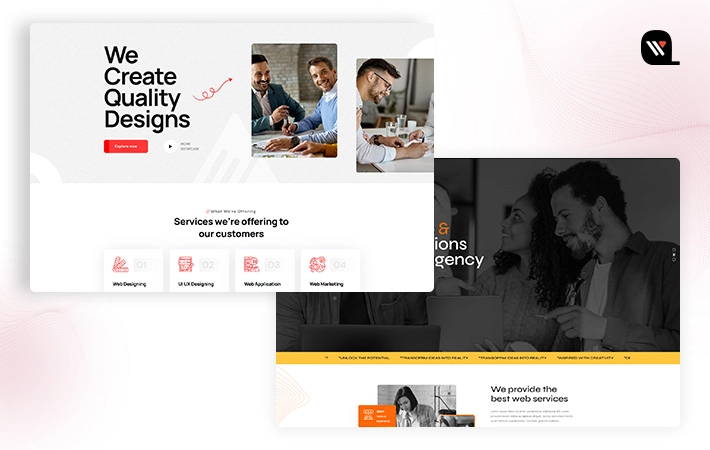
Trend #2. Personalization & AI-Driven Experiences
Relevance is everything. Buyers come to your website with different goals, backgrounds, and levels of urgency. A CTO may be looking for technical documentation, while a marketing lead wants case studies and ROI insights.
When your website delivers the same generic experience to everyone, it misses the opportunity to truly connect.
What does personalization in B2B UI/UX look like?
- Smart content modules that adapt based on user behavior, industry, or job role
- Dynamic CTAs that reflect the stage of the buyer journey
- AI-powered chatbots or assistants offering tailored support in real time
- Customized dashboards or portals for existing clients or partners
Personalization removes friction by helping users get to the information they need faster. Decision-makers want efficiency.
AI enables scale. Machine learning tools help B2B websites adapt in real time without constant manual intervention.
Tailored journeys build trust. When visitors feel seen and understood, they’re more likely to engage, explore, and eventually convert.
Trend #3. Micro-Interactions for Engagement
Micro-interactions are the small, sometimes overlooked elements of design that give digital interaction a sense of responsiveness, intuitiveness, and humanity.
Think of a subtle hover effect, a form field that highlights when clicked, or a gentle animation when a button is pressed.
Although these animations appear insignificant, they hugely contribute to B2B UI/UX design, particularly in an area where it’s harder to gain engagement.
Where micro-interactions show up in B2B UX:
- Navigation cues that show progress (like a progress bar during form fills or onboarding steps)
- Card hover effects, button hover effects, chart hover effects that show additional information without clicking
- Real-time feedback upon an action (e.g., “Form submitted successfully,” “Copied to clipboard,” “Added to dashboard”)
- Animated transitions that direct the eye's attention across one portion to the next
Micro-interactions are not decorative; they’re strategic. They’re a way to say: “We’ve thought about the details because we care about how people experience our brand.”
These interactions might not be called out in a boardroom, but they’re felt in every click, every form, every page transition. And they leave a lasting impression.
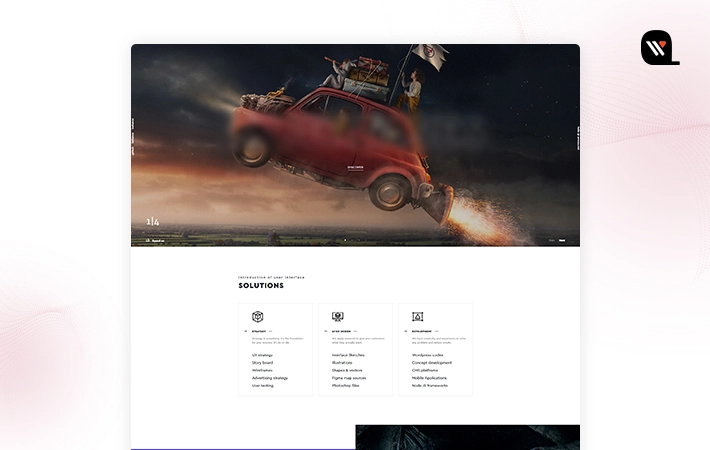
Trend #4. Mobile-First, Performance-Optimized Design
It’s easy to assume that most digital experiences happen on a desktop. But the reality tells a different story. Decision-makers are increasingly browsing solutions, reviewing proposals, and even initiating vendor conversations via mobile.
Whether it’s a quick glance during a commute or reviewing a demo link between meetings, mobile-first UX design has become essential, not optional.
But mobile-first doesn’t just mean “responsive.” It means designing from the smallest screen up, making speed, clarity, and actionability the core pillars of your experience.
After all, mobile is part of the buying journey. A CFO might check your pricing page on a tablet. A tech lead might review your capabilities via mobile before looping in their team.
Google ranks you based on mobile performance. Core Web Vitals now directly impact SEO, affecting visibility in competitive B2B markets.
First impressions happen fast. If your mobile experience lags or feels broken, the assumption is that your service might be the same.
What does a mobile-first, performance-optimized UI/UX look like?
- Prioritized content hierarchy for small screens—headline, value, CTA
- Thumb-friendly interactions, sticky CTAs, and collapsible menus
- Compressed media, optimized images, and lazy loading for speed
- Performance-focused code and reduced dependencies for fast load times
Think of mobile-first design not just as a design principle, but as a commitment to meeting your buyer where they are.
Trend #5. Advanced Data Visualization & Storytelling
B2B decisions are built on data. But here’s the challenge: presenting data isn’t the same as communicating value.
Your audience doesn’t just want to see numbers—they want to understand what those numbers mean for them. That’s where advanced data visualization and narrative-driven UI/UX design come into play.
It’s about using visual hierarchy, interaction, and storytelling to help users make sense of information—faster and more confidently.
When your site presents complex information in a way that’s not just digestible—but engaging—you’re not just informing buyers. You’re empowering them.
What this looks like in modern B2B UX:
- Interactive dashboards that allow users to filter and explore metrics based on their interests
- Animated infographics that explain concepts step-by-step
- Scroll-based storytelling that connects data points to real-world outcomes
- Side-by-side comparisons, ROI simulators, or industry benchmarks embedded in product or service pages
Data is your strongest proof, but without clarity, it becomes noise. A well-visualized insights help teams justify buying decisions internally. And moreover, strategic storytelling turns technical content into persuasive narratives.
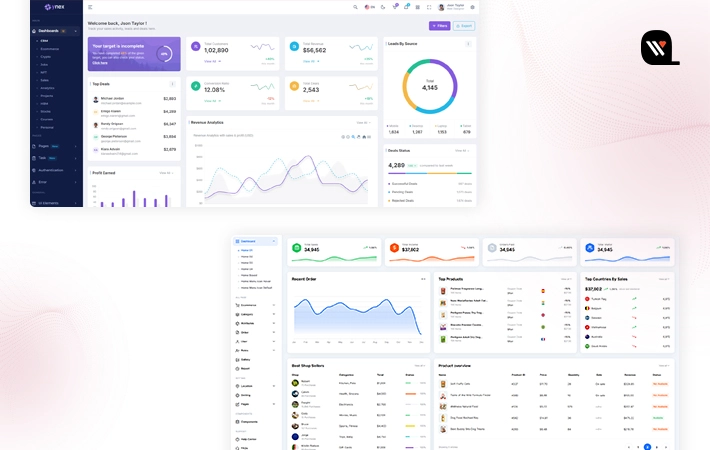
Trend #6. Accessibility & Inclusive Design
Inclusive UX design is becoming a non-negotiable. It’s not just about compliance—it’s about values, reach, and long-term sustainability.
Whether your users are navigating with assistive technologies, dealing with temporary limitations (like low bandwidth or a cracked screen), or simply prefer different interaction styles, your website should offer a consistently smooth, respectful experience for all.
What accessibility in B2B web design looks like:
- Clear visual contrast between text and background for readability
- Keyboard navigation and screen reader compatibility
- Alt-text for images, semantic HTML, and ARIA roles for clarity
- Transcripts or captions for video and audio content
- Logical, predictable navigation and form flows
Accessible sites are often better for everyone. Simpler navigation, clear content, and fast performance benefit all users—not just those with specific needs.
In addition to this, regulations are tightening. Accessibility standards (like WCAG 2.2) are increasingly being baked into legal and procurement requirements—especially in enterprise and government contracts.
Above all, investing in accessibility shows your business is mature, thoughtful, and built for scale.
Trend #7. Video & Interactive Product Demos
No matter how well-crafted your messaging is, there’s a point where your buyers want to see the product in action, experience the flow, or understand how your solution fits into their world.
That’s why video walkthroughs and interactive demos have become a major UX trend across high-performing B2B websites.
They turn passive viewers into active participants—and that’s where confidence starts to build.
What this looks like in modern B2B UI/UX:
- Short explainer videos on key pages (homepage, product, pricing, use cases)
- Interactive demos that allow users to click through features, explore interfaces, or simulate outcomes
- Personalized demo experiences tailored by industry or role
- Embedded video testimonials or scenario-driven product use cases
Video and interactivity aren’t about looking flashy—they’re about meeting your buyers where they are: curious, busy, and skeptical.
When your website offers a guided experience that feels clear, transparent, and immersive, you’re removing barriers and building trust at the same time.
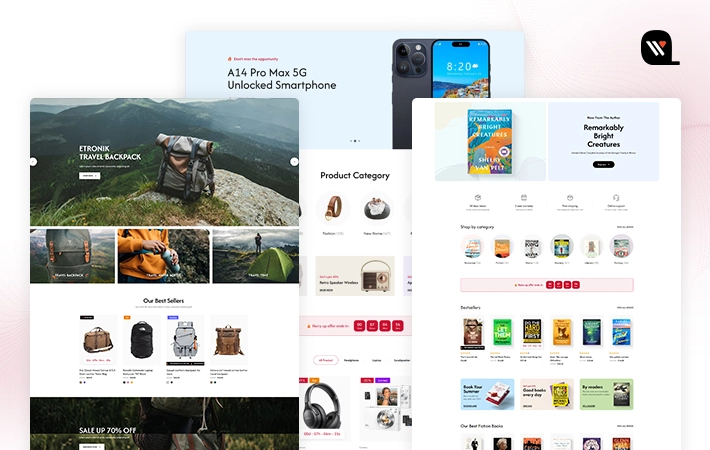
Avoid These Common UI/UX Pitfalls in B2B Website Design
Adopting the latest UI/UX design trends can elevate your B2B website—but only when applied with clarity, purpose, and user understanding. Without strategic execution, even the most promising trends can backfire, confusing users, hurting conversions, or diluting your brand message.
Here are common mistakes B2B leaders and designers must actively avoid—and what to do instead:
1. Chasing Aesthetics Over Conversions
Over-prioritizing sleek visuals without considering the buyer journey.
Every layout, interaction, or animation should lead users toward a specific business goal—whether that’s requesting a demo, downloading a whitepaper, or booking a call. Keep it conversion-focused, not just pretty.
2. Overusing Personalization Without Value
Implementing AI-driven personalization that feels invasive or irrelevant.
Use user behavior, role-based logic, or firmographics to enhance relevance—but always give users control. Respect privacy and keep personalization subtle and helpful. Make it feel intelligent, not intrusive.
3. Adding Micro-Interactions Without Intent
Using hover effects, animations, and transitions that serve no functional purpose.
Micro-interactions should reinforce clarity—highlight a CTA, validate form inputs, or show feedback. Avoid flashy distractions that hinder usability. Delight through simplicity, not gimmicks.
4. Ignoring Mobile Optimization
Designing desktop-first and trying to retrofit it for mobile later.
Adopt a mobile-first UI design approach from day one. B2B buyers are increasingly on mobile—ensure fast load times, thumb-friendly CTAs, and clean navigation. Mobile is not secondary—it’s primary.
5. Overcomplicating Data Visualizations
Presenting charts or dashboards that look impressive but confuse decision-makers.
Use visual storytelling to break down complex data into actionable insights. Choose clarity over cleverness. Highlight trends, not just numbers. Your data should talk, not puzzle.
Trends are only effective when anchored in strategy and empathy. Also, it is important to stay aligned with what your users actually need to move forward confidently.
How to Choose UI/UX Trends That Fit Your B2B Needs
With so many UI/UX design trends making waves, it’s tempting to apply them all. But in B2B, success lies not in how many trends you follow, but in how well they align with your customer experience goals, buyer intent, and industry context.
Here’s how to choose the right UI/UX elements for your B2B website—smartly, intentionally, and impactfully:
Start with Your Buyer Journey
Start by asking: What are your visitors looking for when they land on your site?
Your UX should guide them—intuitively—from awareness to trust to action. Whether they’re exploring solutions, comparing vendors, or ready to request a quote, your design choices should meet them where they are.
Use trend elements like micro-interactions or data visualization to simplify complex buying decisions, not overwhelm them.
Match Trends to Business Goals
Not every interaction needs a trend. Some need clarity.
If your priority is more demo sign-ups, consider minimalist layouts with clear CTAs. If you want to showcase product complexity, invest in interactive product demos or video walkthroughs.
Align every UI/UX element with a measurable outcome—lead quality, engagement time, or conversion rate.
Stay Future-Focused, But User-Centered
A trend is only valuable if it enhances user experience for the long haul.
Look beyond visual appeal. Will this trend scale as your product evolves? Does it improve accessibility? Will it work seamlessly across devices?
Conduct UX audits regularly. A professional B2B UI/UX design partner can help you evaluate what’s working and what’s just noise.
Prioritize Performance & Personalization
Speed, relevance, and smooth interaction are non-negotiable.
If your B2B users are enterprise clients or time-strapped professionals, the design must perform fast, feel personalized, and avoid friction.
Consider tools like AI-driven personalization or mobile-first design frameworks—implemented by teams that understand the tech and the psychology behind them.
When in Doubt, Test—Then Optimize
No trend should go live without validation.
Even small changes in design can shift engagement drastically. A/B test your UI elements, collect heatmaps, and gather user feedback to refine experiences iteratively.
Partner with a team that offers continuous UX optimization—not just one-time design.
Future Trends in UI/UX Every B2B Website Should Watch
Agentic AI & Generative Interfaces – Interfaces that proactively assist users by generating content, suggestions, and decisions using AI.
Voice, Ambient & Zero-UI Experiences – Seamless interactions using voice or background automation—no buttons, just intuitive actions.
Spatial Computing & AR-Driven Visuals – Blending physical and digital worlds with immersive, 3D experiences using AR and spatial tech.
Predictive UX Powered by Real-Time Analytics – Smart interfaces that anticipate user needs before they act, reducing friction and improving flow.
Final Thought
Trends will come and go, but great UI/UX design is about knowing which ones to lean into, and when to say no. Especially in B2B, where the goal isn’t just to look good—it’s to build trust, speed up decisions, and quietly guide users toward the right action.
If you’re at a stage where your site needs to not just look better but perform better, now might be the right time to explore what thoughtful, strategic UI/UX design services can do for your business. Because in a B2B world where attention is earned, experience speaks louder than words.
Frequently Asked Questions
#1. What is the Biggest UI/UX Trend for B2B Web Design in 2025?
#2. Do UI/UX Trends Directly Impact SEO Rankings?
#3. Which Tools are Best for B2B UI/UX Design Updates?
Top tools for updating your B2B website with the latest UI design trends include:
- Figma – for collaborative interface design
- Adobe XD – for wireframing and prototyping
- Hotjar / Crazy Egg – for tracking UX behavior
- Google Optimize – for A/B testing UI/UX changes
- Webflow / WordPress with advanced UI plugins – for front-end flexibility
#4. How Can Small B2b Businesses Adopt These Trends on a Budget?
Start with:
- Template-based minimal UI design for clean layouts
- Using freemium UX tools like Figma and Google Analytics
- Implementing AI-powered chatbots or forms for personalization
- Prioritizing mobile-friendly, fast-loading designs
